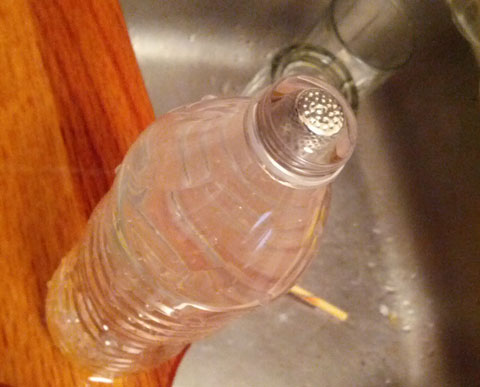Sewing Kit Cartesian Diver
Here's a five-minute version of a demonstration that’s been delighting since its invention in the 1600s.
In our last Physics@Home post, we talked a little about the behavior of fluids. This week, we’re going to take advantage of some of the more interesting properties of fluids to demonstrate important concepts about pressure and buoyancy.
What You Need
- A transparent, disposable plastic bottle
- A metal thimble (small enough to fit in mouth of bottle)
What to Do
1. Fill the bottle with water all the way to the mouth. Place the thimble open-side down on top of the
water. Note that, even though it’s metal, it floats on the surface thanks to the air trapped under it.
2. Fill the thimble about halfway with water, and upend it into the water bottle. The idea is to get the
thimble to almost-neutral buoyancy, where there’s just enough air trapped under it to keep it afloat.
This may take a few tries, but it makes your job a LOT easier later on.
3. Trickle water into the mouth of the bottle until it begins to overflow. Then, add the cap and seal it
tightly. Here, we’re trying to make sure the only air left in the bottle is the stuff trapped under the
thimble.
4. Squeeze the bottle tight, and watch what happens!

What the thimble should look like placed at the top of the bottle.
What's Going On?
A thimble can float on water as long as the amount of water it would take to fill the thimble weighs more than the thimble itself. That’s because the buoyant force depends on the volume and density of the liquid displaced. Since water weighs exactly one gram per cubic centimeter, a thimble that weighs one gram would need about one cubic centimeter of air trapped under it to keep it afloat.
Unlike the molecules in a liquid, the molecules in a gas can be pushed together pretty easily. For example, the volume of a balloon depends on the air pressure of the room that it’s in. If the bottle contained just water, it would be practically incompressible—squeezing it might change the shape, but wouldn’t change its volume at all. But if you look at the bottle from below while you squeeze it, you may be able to see that the air bubble trapped under the thimble gets compressed as you squeeze. When the volume of that air bubble shrinks enough that it’s not displacing the thimble’s weight in water, gravity overcomes buoyancy and the Cartesian diver does his thing.
A demonstration of how the experiment should work. If at first you don't succeed, try again!
Apply It!
Open the cap of the bottle and pour a little out, without changing the amount of air in the thimble. Reseal the bottle and try the experiment again. What happens? Why?
-Stephen Skolnick














